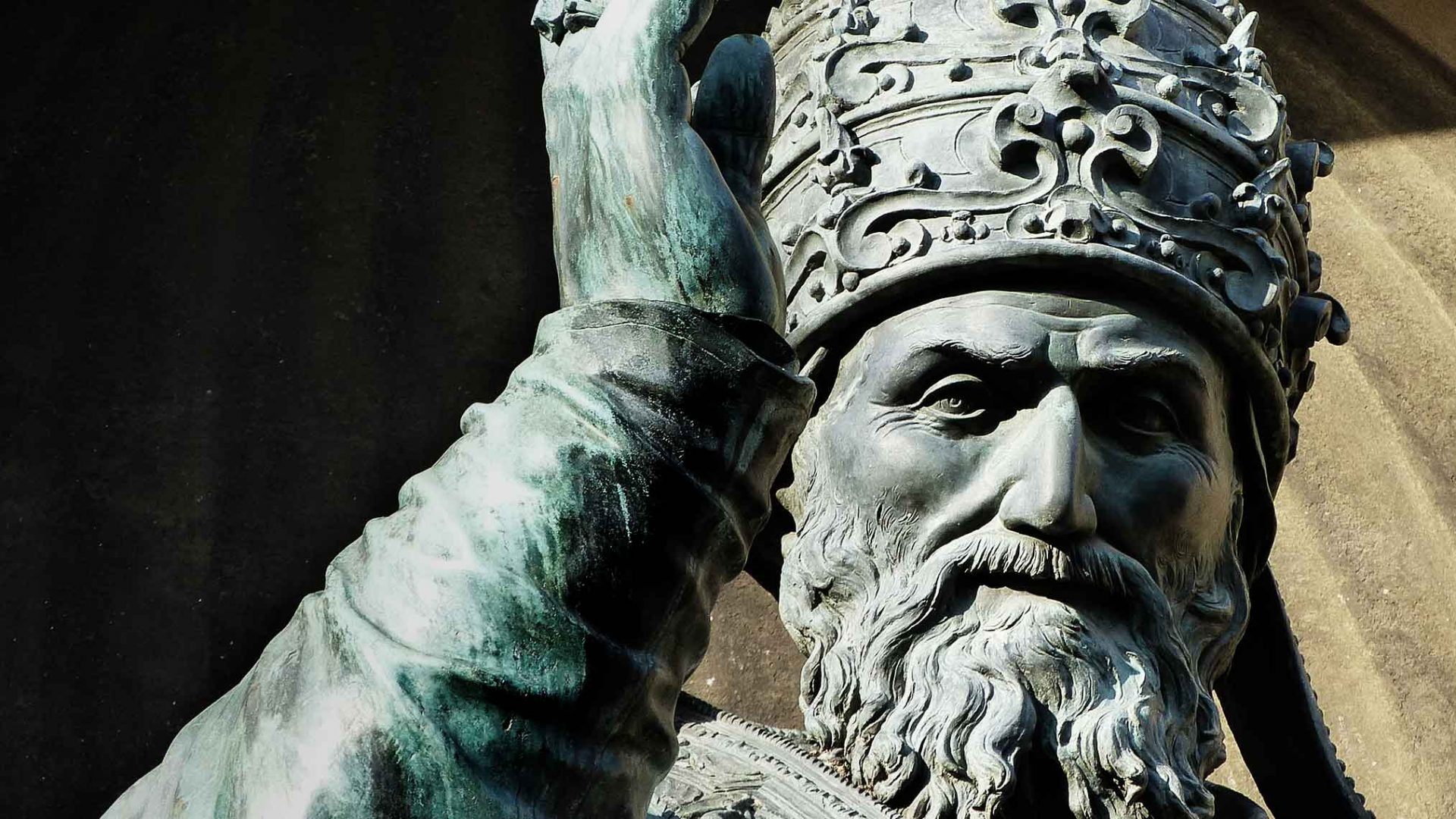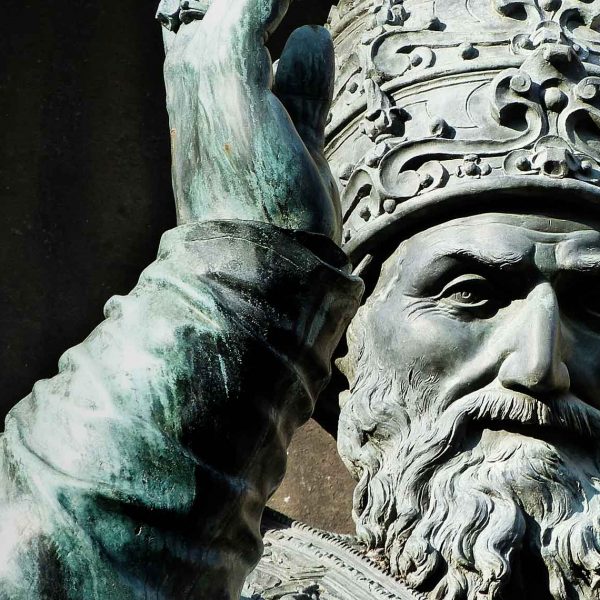
via del Monte 8, Bologna (Italy)
t +39 051 236760
info@palazzoboncompagni.it
Palazzo Boncompagni is social

Ugo Boncompagni, cadet son of a prominent Bolognese merchant family, was not destined for the Church.
A bright young man, he studied law and then pursued a career as a university lecturer in Bologna. At 37, he dropped out of the university and decided to take his vows.
Between lights and shadows, we trace the stages of Ugo Boncompagni’s life before and after his election as pontiff: his birth, his family, his career as a jurist and as a man of the church.

A statue of him dominates Piazza Maggiore in Bologna. It is a bronze colossus over three meters high, which overlooks the monumental balcony of Palazzo d’Accursio, the town hall of the city. It is the statue of a Pope solemnly dressed in vestments with a triple crown on his head, a symbol of his supreme power. But who is this severe, imposing and blessed Pontiff that the Bolognese sculptor Alessandro Menganti fashioned in bronze in around 1575?
The large writing superimposed on the statue says “divus Petronius, Protector et pater”. However, the inscription is misleading. In fact, it is not a question of San Petronio, who was never a Pope, but one of the greatest popes in the history of the Church. We are talking about Gregory XIII, the Bolognese Ugo Boncompagni, supreme guide of Catholics from 1572 to 1585.
Why then does the inscription say “Divus Petronio”? With the arrival of French troops in Bologna in 1796, the Bolognese feared that the statue would be seen as a symbol of the Pope’s power and therefore destroyed, so the sculpture was camouflaged in such a way that it resembled that of the patron saint of Bologna: the bishop San Petronio. They replaced the papal tiara with the bishop’s miter, added a crosier in his hand and inscribed the name of San Petronio.
The sculpture was only restored in 1895 and Pope Gregory XIII Boncompagni would return to recover the papal connotations.
But who was Ugo Boncompagni? How did his life unfold and how did he arrive at Peter’s throne? And finally: what traces did his pontificate leave in the history of the Church and of the world? Ugo Boncompagni was born in Bologna on January 1st 1501, in the large family palace a few steps from Piazza Maggiore.
His parents, Cristoforo Boncompagni and Angela Marescalchi, allowed him to study jurisprudence at the University of Bologna and here Ugo Boncompagni graduated cum laude in 1530 in utroque iure, that is, in civil and ecclesiastical law. A brilliant career as a professor of law awaited him at the same university in Bologna, an activity that engaged him between 1531 and 1539, and that saw, among his pupils, such prominent personalities as Alessandro Farnese, who would later become pope with the name of Paul III and the future cardinals Cristoforo Madruzzo, Reginald Pole and Carlo Borromeo.
But in 1539 Ugo Boncompagni gave up his university chair and decided to pursue an ecclesiastical career. On June 1st of that year he received the tonsure in Bologna and went to Rome to enter the service of Cardinal Pier Paolo Parisio. The reigning pope and his former pupil Paolo III Farnese entrusted him with important juridical tasks, such as that of first judge of the capital.
Then, in 1546, the pontiff sent him to the Council of Trent. In Trento, Boncompagni was considered an eminent expert in canon law and was involved in key issues such as the obligation of the residence of bishops and disciplinary reform.
In 1548 a secret and very singular event happened: Cristoforo Boncompagni, Ugo’s father, passed away leaving his sons a conspicuous inheritance. The ecclesiastical son received a substantial part which included, among other things, half of the large family palace in Bologna. A pressing question arose within Ugo Boncompagni: who would inherit this huge patrimony after him? The prelate found the answer to the question by himself.
He identified among the house staff a single woman, Maddalena Fortini, willing to secretly give him a child. On May 8th 1548, Giacomo Boncompagni was born in Bologna and Ugo immediately legitimized him. He also provided for his mother. He allowed her to marry a bricklayer named Simone Scambi and awarded her a generous dowry.
Ugo Boncompagni’s secret son did not interfere in any way with the character’s brilliant ecclesiastical and curial career. Recognizing his great qualities as a jurist, the new Pope Paul IV Carafa used him for various diplomatic missions and also appointed him Bishop of Vieste. Towards the end of 1561 Bishop Boncompagni was again sent to the Council of Trent and here, thanks to his competence and efficiency, he rendered valuable services for the resolution of some juridical problems in the last conciliar session.
At the end of the council, the bishop Boncompagni returned to Rome and on March 12th 1565 he was awarded the cardinal’s hat. Pope Pius IV Medici appointed Cardinal Boncompagni “legate in Spain”. It was 1565. The diplomatic mission led him to personally meet King Philip II of Habsburg, who appreciated the intelligence and character of the papal legate. This meeting would play a decisive role at the moment of Boncompagni’s candidacy for the papal throne.
In fact, on the death of Pope Pius V, on May 1st 1572, the name of Boncompagni immediately emerged among those of the eligible candidates. The solid juridical preparation and the experience gained in the Curia, together with the decisive support of the King of Spain, all played in his favor. Thus, in the very rapid conclave that was held between May 12th and 13th 1572, Ugo Boncompagni was elected Pope.
He chose the name of Gregory XIII in honor of the great Pope St. Gregory the Great. Despite already being seventy years old, the new pope immediately showed great energy and a firm will to continue the work of the radical renewal of the Church begun by Pius V. He committed himself to the implementation of the Tridentine reform through the systematic application of all the conciliar decrees. For the government of the state he surrounded himself with trusted collaborators and relatives, including his son Giacomo, whose social rise he favored by appointing him castellan of Castel Sant’Angelo and gonfalonier general of Santa Romana Chiesa, the highest military office of the Papal State. He also married him to the rich noblewoman Costanza Sforza of Santa Fiora and gave him the marquisate of Vignola, the Duchy of Sora and the county of Arpino.
A colleague cardinal confessed to the Pope that if he had known about this illegitimate son he would not have voted for him in the conclave. Gregory XIII was not angry with this comment and replied with a subtle irony: “Well, but the Holy Spirit knew it”.
Gregory XIII was a tireless Pope. He promoted the formation of the post-conciliar clergy, erecting institutes that formed priests who were culturally ready to face and stem the Protestants. Therefore numerous colleges arose in Rome and everywhere in Catholic countries, whose management was entrusted in particular to the Society of Jesus. The Jesuits were always excellent collaborators of Pope Gregory, who granted support to the Roman College founded by St. Ignatius of Loyola, then expanding this institution into the Pontifical Gregorian University, which was named after Pope Gregory XIII.
Always availing himself of the help of the Jesuits, he created the English College, Germanic College and Hungarian College in Rome and, moreover, he showed his interest in the consolidation of the Union among the Eastern Churches by creating Greek, Armenian and Maronite colleges in the capital. Gregory XIII took care of the reform of the Carmelites of Spain with the help of Saint Teresa of Avila and established the congregation of the oratory of San Filippo Neri.
He put his great experience as a lawyer to good use by also publishing the Corpus Iuris Canonici, which was a set of laws and decrees to regulate the life of the Church and with the same juridical attitude he published the Martyrologium Romanum to define exactly the dates on which to celebrate the ceremonies of the saints and blessed of the Church. He was also a very active pope in foreign policy, strenuously supporting and safeguarding the interests of Catholicism everywhere.
He managed to maintain Catholic positions in the Netherlands, in Poland and also in Germany, where, thanks to the intervention of the Dukes of Bavaria and some German ecclesiastical princes, Protestantism was arrested in its expansion. Instead, substantially unsuccessful were the attempts to recapture England to the Catholic cause, supporting any action aimed at destabilizing the power of Elizabeth I Tudor. He couldn’t get any results.
Other black pages were written during his pontificate. This total aversion to Protestants led him to solemnly celebrate the massacre of the Huguenots in Paris, which took place at the instigation of Caterina dei Medici, shortly after his election as pontiff. He took heinous steps to try to convert the Jews and then promoted a strict control of the press through the tools of ecclesiastical censorship.
With the constitution Ut pestiferarum Opinionum Gregory XIII made executive the decision taken by Pius V, that is, to compile the index of forbidden books. On another front, however, he was a generous Pope. He did not fail, for example, to tackle the problem of poverty and food crises. And then he tried to favor the pawnshop in order to lower the interest of loans.
Another positive aspect were the nunciatures, the dialogue with the powerful of the earth, and he is considered the father of modern nunciatures. Their structure would not be modified until the contemporary age. His role in the development of the arts and sciences should also be highly considered. In the field of archeology, for example, he recognized the discovery and importance of the Roman catacombs. On that of music he gave Giovanni Pierluigi da Palestrina the task of identifying and eliminating the errors that, over the centuries, had entered the ancient Gregorian pages. On the other hand, famous monuments arose at his behest, such as the Quirinal Palace in 1580, the Gregorian Chapel in St. Peter’s Basilica and the Gallery of Geographical Maps in the Vatican. And with his support, the marvelous Church of Gesù in Rome was also completed.
However, the undying fame of this pope is linked to the fundamental reform of the calendar: the Gregorian calendar that bears his name and is still universally in use today. The affirmation of Catholicism was a must for Gregory XIII. And he inserted himself into the broader framework of the evangelization of non-Christian populations and therefore gave a great impetus to missionary activity. The main instrument of this operation was once again the Society of Jesus and it was in the Far East, thanks, above all, to the work of Matteo Ricci in China and Alessandro Valignano in Japan, that the missionary commitment of the Jesuits produced significant results.
In the spring of 1585 the pontiff had the satisfaction of welcoming the first Japanese delegation to Europe, which arrived in Rome after a trip that lasted three and a half years and was made up of young Japanese princes and aristocrats, all converted to Christianity. The solemn embassy of these first Japanese Christians was one of the last public outings of the pontiff who, after a very short illness, died on April 10th 1585 at the age of 84, in the midst of his faculties and activities.
His body was placed in St. Peter’s Basilica in a tomb which in 1723 was admirably adorned with sculptures by Camillo Rusconi.
Gregorius: Ugo Boncompagni, A Great Bolognese Pope.
A podcast in three written episodes narrated by Marco Carminati and directed by Ottavia Casagrande